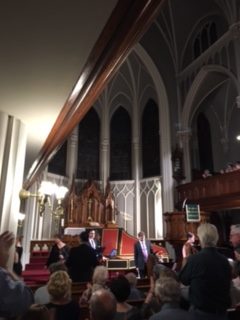 The world probably wouldn’t be appreciably different had Bach’s Brandenburg Concertos not been discovered sitting on some shelf, possibly unplayed and unexamined, a century or so after they were finished in 1721. J.S. Bach still would’ve been re-discovered. His works would be as venerated as they are now. But the Brandenburg Concertos are so singular in Bach’s output, in the history of concertos or, for that matter, in western music that their impact on audiences was inevitable. But their influence on composers? Well, who else but J.S. Bach could’ve gone there?
The world probably wouldn’t be appreciably different had Bach’s Brandenburg Concertos not been discovered sitting on some shelf, possibly unplayed and unexamined, a century or so after they were finished in 1721. J.S. Bach still would’ve been re-discovered. His works would be as venerated as they are now. But the Brandenburg Concertos are so singular in Bach’s output, in the history of concertos or, for that matter, in western music that their impact on audiences was inevitable. But their influence on composers? Well, who else but J.S. Bach could’ve gone there?
Templates for these kinds of concertos certainly existed in the 18th century, but Bach took to them to such a different place, a place that becomes more and more specific as historically-informed performance practice zeros in on what’s really there – as exemplified by the Labor Day-weekend Brandenburg performances by the Sebastians, a chamber group that played five of the six concertos Saturday at St. Paul’s German Lutheran Church.
The clarity, specificity and personality that the conductor-less Sebastians brought to each concerto illustrated – perhaps more than in Bach’s religious works that are obliged to express a pre-set text – how the composer achieved miracles of total unity amid maximum diversity. With the solo roles constantly reassigned to different instruments, you’re tempted to call these pieces concertos for orchestra. But they’re more like concertos for everything.
Michael Tilson Thomas talks about the short-term miracles of musical coalescence achieved in jazz, when a series of preset chord progressions and improvisational inspiration come together with transcendent cumulative effect. The difference in classical – if I’m understanding him correctly – is that these miracles build over longer arcs in which the composer’s thought process is constantly apparent but with a seemingly contradictory element of surprise. But Bach is not subject to the contradictions of most creative personalities.
The music is certainly agreeable. one reason why these deeply respected pieces are also entry-level Bach. But I returned to the old 1977 Gustav Leonhardt recordings that set standards in their own way, though what I heard upon revisitation was a sense of overall integration rather than individual liberation. Anyone who listens seriously to Bach can hardly be immune to the new musicology in recent years, headed by Susan McClary, who hears the harpsichord solo in Brandenburg Concerto No. 5 as an expression of emancipation of the individual. Certainly, something important and unprecedented must be at work in the concerto’s 65-bar harpsichord solo that’s extravagant even by Rachmaninoff standards in a much later generation.
McClary is hard to prove or disprove, though your gut tells you there has to be an extramusical reason why the solo is so audacious. And it’s this kind of thinking that the Sebastians seem to have applied to virtually every bar in the five concertos (all but No. 1) that the group played. Every time a particular motif made the rounds, being passed among different instruments as in the first movement of Brandenburg Concerto No. 3, it became an animated conversation.
With that came a far more subversive quality, and one you would never have gotten from the old lumbering Brandenburgs conducted by Pablo Casals or even Leonhardt: Humor. That’s not what music was for in Bach’s world, where he mostly lived in the choir loft, rarely facing his audience or hearing applause. Yes, broad humor is heard in some of Bach’s secular cantatas, but it’s nothing like the humor that bubbles up from the Brandenburg concertos, with musical elaborations piling on top of each other with a giddy sense of brinksmanship.
However smart the playing, the Sebastians weren’t good in the correctness sense of the word. Spirit took precedence over meticulousness, but so infectiously that I don’t think I’d ever want to go back to well-drilled Brandenburg performances.
The historically-informed performance movement initially felt like a corrective measure, a purgatory where we were paying for our sinfully lumbering Casals Brandenburgs that we once held up as a standard. From there, the music went into sort of God-less limbo, stripped of cultural trappings with a severity that the music’s surfaces, at least, had a kind of Zen-like quality that told you the music was saying important things but the performer wasn’t going to give you any help at all on figuring them out. Ditto for Keith Jarrett’s Bach recordings. Though Bach performances don’t necessarily super-cede their predecessors, I wonder why I ever loved the aforementioned Leonhardt recordings, even with such notable sidemen as Frans Bruggen. The Sebastians’ performances had a face, smell and color that I didn’t know I was missing. What did we ever do without those qualities? At times, I felt like I was hearing the music for the first time.


“Face, smell and color” I loved that, David. So much “historical performance’ we get subjected to is numbingly boring and soulless. The Sebastians’ recording looks, sounds and smells nice, from your description. I’m ordering it.